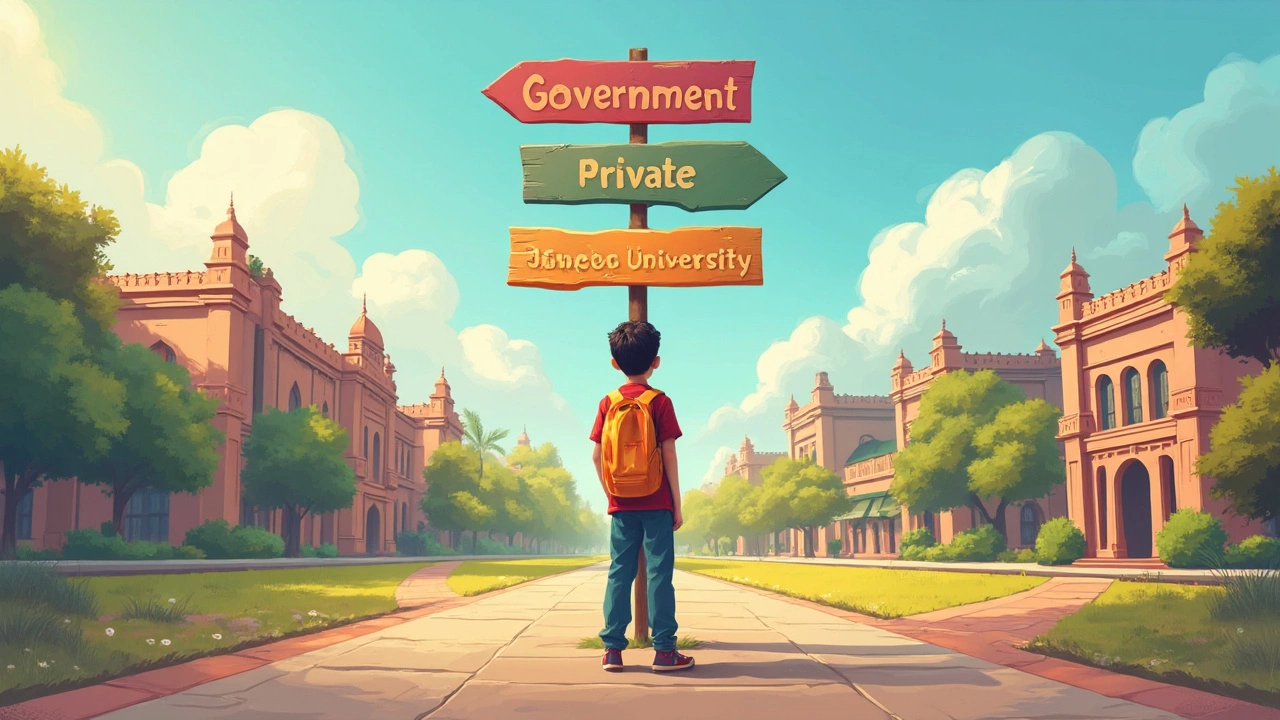MBBS Fees in India: What You Really Pay for a Medical Seat

Everyone talks about becoming a doctor, but hardly anyone gets into the real talk: what does it actually cost? If you or someone in your family is aiming for an MBBS seat in India, the price tag will probably give you whiplash. The fee isn’t the same everywhere, and the gaps are wild. In 2025, a single year in a government medical college can cost less than your annual mobile bill, while a private college might charge you more than some apartments in Delhi or Mumbai.
Let’s get right to the point—knowing these numbers ahead of time is crucial. Some families think they’ll squeak through with minimal fees, only to get walloped by hostel charges, books, and even random ‘development’ fees. Parents often start planning for MBBS fees when their kid is still learning multiplication tables, and for good reason. Even if you ace the NEET, the line between a dream and a budget-buster is thinner than you’d expect.
Understanding how MBBS fee structures work is your first defense against nasty surprises. Government colleges, central universities, private medical colleges, and those famously pricey ‘deemed’ universities—they all play by their own rules. The trick is to compare real costs, not just the basic tuition. Don’t fall for quick online charts. Dive deeper, and you’ll find legit ways to save, plus some surprising hidden costs people forget to mention.
- MBBS Fees in Different Types of Colleges
- Hidden and Extra Costs to Expect
- Scholarships and Fee Waivers: Your Best Bets
- Tips for Handling MBBS Expenses
MBBS Fees in Different Types of Colleges
If you’re googling MBBS fees in India, you’ll notice there’s no one-size-fits-all answer. The fees you pay depend on where you get in and what kind of college it is—government, private, or deemed university. Each one hits your wallet differently, and honestly, the gaps can be massive.
Let’s break it down with actual numbers, so you know what you’re signing up for in 2025:
- Government Medical Colleges: These are hands down the most affordable option if you get a NEET seat. Fees range from as low as ₹10,000 a year (yes, really!) to about ₹1,50,000 per year. For instance, colleges like Maulana Azad Medical College in Delhi or Seth GS Medical College in Mumbai still charge under ₹50,000 a year for tuition in most general categories. SC/ST and OBC reserved category students often get reduced fees. Not all states keep fees low—Uttar Pradesh and a few others go higher, so always check your target state's latest numbers.
- Private Medical Colleges: Here’s where the numbers start making parents sweat. In 2025, most private colleges charge between ₹7,00,000 and ₹22,00,000 per year. Some places in Karnataka and Tamil Nadu have slightly lower fees if they have a trust or minority quota, but it’s usually pricey. These costs jump if you’re in the management quota (where donation/capitation might also sneak in above official charges).
- Deemed Universities: These are the real high-flyers. Famous names like Manipal, KMC, or SRM easily charge between ₹18,00,000 to ₹30,00,000 or more per year. Some students finish MBBS here with a final bill near ₹1.3 crore. Certain deemed universities also ask for ‘admission processing fees’ and other add-ons you don’t see coming until your seat is almost confirmed.
Here’s a table to make things clearer:
| Type of College | Average Yearly Fee (₹) |
|---|---|
| Government Medical College | 10,000 – 1,50,000 |
| Private Medical College | 7,00,000 – 22,00,000 |
| Deemed University | 18,00,000 – 30,00,000+ |
Quick tip: When checking fees, always confirm if the numbers you see are for tuition only or if they sneakily leave out hostel, mess, caution deposit or other regular costs. And don’t trust random ‘cheapest MBBS’ lists—these change every year and sometimes even mid-admission season.
Hidden and Extra Costs to Expect
When you hear about MBBS fees in India, what pops up first is the official tuition. But there’s a whole bunch of extra costs that most students and parents don’t see coming—until the bills start piling up.
Let’s break down where your money actually goes, beyond the main MBBS fees:
- Hostel and Mess Charges: Most government and private colleges make hostel stay mandatory for at least the first year. Government college hostels can be as cheap as ₹5,000–10,000 per year, but private ones may hit ₹1–2 lakh per year. Mess (food) charges often add another ₹3,000–6,000 per month.
- Books and Study Stuff: Medical textbooks are expensive. Even with smart buying, expect ₹15,000–40,000 per year for books, plus a bit more for lab equipment like dissection kits and lab coats.
- Exam Fees: Colleges charge separate fees during internal and university exams, usually ₹2,000–10,000 each time, not included in tuition.
- ‘Development’, Caution, or Security Fees: These can sound harmless, but some colleges ask for a one-time non-refundable sum, anywhere from ₹10,000 up to ₹1 lakh, right when you join.
- Other Random Charges: Registration fees, medical insurance, student union dues, and mandatory events/kits are common. They sneak up to another ₹10,000–₹25,000 per year, depending on the college.
- Travel and Clinical Rotations: Most students underestimate these. If your hospital postings or rural internships are far from campus, travel and extra food costs can rack up quickly.
Here’s a quick look at what the ‘extras’ might add up to over 5 years for a typical student:
| Expense | Government College (5 yrs) | Private/Deemed College (5 yrs) |
|---|---|---|
| Hostel & Mess | ₹1–2 lakh | ₹4–10 lakh |
| Books & Kits | ₹1 lakh | ₹1.5 lakh |
| Exam & Registration Fees | ₹30,000 | ₹50,000 |
| Other Charges | ₹40,000 | ₹1 lakh |
So, if you’re checking out the cost of MBBS in India, don’t stop at the admission brochure. Talk to seniors in the college (they won’t sugarcoat reality) and ask about these extras. Also, keep a small fund aside for medical insurance, as some colleges make it mandatory and add it to your bill.

Scholarships and Fee Waivers: Your Best Bets
If you think the only way to handle MBBS fees in India is by emptying your savings, think again. Scholarships and fee waivers can shave off a big chunk of the cost, and surprisingly, a lot of people don’t dig deep enough to grab them. Here’s what actually helps:
- Central Government Scholarships: Schemes like the Central Sector Scheme of Scholarships for College and University Students can provide up to ₹20,000 per year if you scored well in Class 12 and fit the family income cap.
- State Government Schemes: States like Maharashtra, Tamil Nadu, and West Bengal have their own scholarships for medical students, especially for those from reserved categories (SC, ST, OBC) or those with parent income below 2-6 lakh a year.
- Private and NGO Scholarships: Reliance Foundation, Tata Trusts, and Dr. Ambedkar Medhavi Chhatravriti Yojana all offer support. Some are merit-based, others focus on financial need. Always double check their latest guidelines, because they change every year.
- Fee Waivers in Government Colleges: Believe it or not, some government and AIIMS colleges let you apply for a full or partial fee waiver. This usually goes to those in the lowest income brackets. Sometimes just presenting a BPL certificate or income proof is enough.
- Special Quotas: If you’re a ward of armed forces personnel, ex-servicemen, or have a disability (PWD quota), there are extra relaxations and dedicated scholarships up for grabs.
Here’s a snapshot of a few main scholarships and what they offer (as of 2025):
| Scheme Name | Who Can Apply | What You Get |
|---|---|---|
| Central Sector Scheme | Top 20th percentile in Class 12; income < ₹8 lakh | ₹10,000-₹20,000 per year |
| AIIMS Fee Waiver | BPL/low-income students | Tuition fee waiver (up to 100%) |
| Tata Trusts Medical Scholarship | Merit and financial need | Up to 80% of tuition fee |
You don’t have to chase every single option—just focus on the ones you actually qualify for. If your school offers a guidance counselor, use them. And don’t forget to check valid deadlines and required documents—one missing paper can shut the door instantly.
Tips for Handling MBBS Expenses
The fees for MBBS in India can hit hard, but there are smart ways to keep your costs under control so you don’t end up scrambling in the middle of your medical journey. Here’s what actually works if you want to make it through without sinking under bills.
- Always compare real costs, not just tuition. Hostel fees, mess charges, books, instruments, and little expenses (like club fees or exam fees) add up fast. For example, private colleges may have annual hostel charges ranging from ₹1 lakh to ₹1.5 lakhs, while books and supplies can cost ₹30,000–₹50,000 each year.
- Ask for a detailed fee breakup. Don’t just trust what’s on big banners or websites—request a full list. Many colleges update their "miscellaneous" or "development" charges every year and new students often get a shock in the first semester.
- Use government and private scholarships. States like Maharashtra and Tamil Nadu have merit-based scholarships, while the central scheme offers the National Means-cum-Merit Scholarship—worth checking for families with annual incomes below ₹8 lakhs. Many private and minority trusts also give targeted support, and some banks work with colleges to offer education loans with lower interest rates for MBBS seats.
- Consider education loans from major banks. SBI, HDFC, and Axis Bank offer loans that cover tuition and living costs for MBBS, often letting you start repayments after completing the course. Interest rates usually float around 9–11%, but some banks offer a 0.5% reduction if you set up autopay.
- Plan hostel life smartly. Hostel costs vary a lot—government college hostels are the cheapest (as low as ₹4,000–10,000/year), but private colleges may go ten times higher. Check if external rental options or sharing with classmates gets you a better deal.
- Reuse and rent textbooks or instruments. Borrow from seniors or buy used. Many MBBS students save thousands this way rather than buying new every year. Classroom WhatsApp groups can be solid for textbook exchanges.
- Track your expenses monthly. Apps like Walnut or Goodbudget help you spot where your money’s leaking, and this becomes super important when managing limited funds during internships.
Here’s a quick comparison table that’ll give you a starter idea:
| Expense Category | Government College (per year) | Private/Deemed College (per year) |
|---|---|---|
| Tuition Fees | ₹20,000–80,000 | ₹8–20 lakh |
| Hostel & Mess | ₹6,000–25,000 | ₹1–2 lakh |
| Books & Supplies | ₹15,000–30,000 | ₹30,000–50,000 |
Small savings here and there might not sound like much, but they add up big by the end of five years. If you’re planning to crack NEET and score an MBBS seat in India, early budgeting and a sharp look at real costs can save your family a lot of stress down the line.

